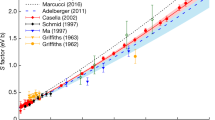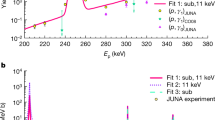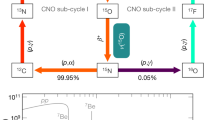Abstract
ACTIVITIES due to long-lived 92Nb (t1/2 ≃ 1.7×108 yr) and to 94Nb (t1/2 = 2.03×104 yr) in a refined bar of terrestrial niobium were discovered by Apt et al.1. They speculated that the 92Nb activity could have applications to chronologies of nucleosynthesis and to cosmogony. As an example, they calculated that their observed activity level would result if the isotopic ratio 4.7×109 yr ago were 92Nb/93Nb = 10−3 and if the halflife were 1.58×108 yr. More definite conclusions were difficult because the concentration expected today depends so strongly on the poorly known halflife, which they estimated to be 1.7×108 yr from a reactor irradiation. This sensitivity can be illustrated by noting that a 5% error in halflife corresponds after 4.7×109 yr to an error of a factor 2.74 in the anticipated activity. Quantitative calculations from galactic nucleosynthesis must therefore await a more precise measurement of the halflife. Implications of primordial 92Nb have recently been enlarged with the proposal2 to use enrichments δ(92Zr) in the isotopic composition of Zr due to extinct 92Nb to measure absolute time differences in the formation of meteorites and planets. If an initial 92Zr/94Zr ratio for each body can be obtained, differences between those initial values could be translated into time differences in the formation of the respective objects. We argue here that both projects are probably doomed to disappointment. It seems to us unlikely that the near equality in the two measured activities is a coincidence. They are respectively 0.058±0.035 d.p.m. per kg (Nb) for 92Nb and 0.32±0.03 d.p.m. per kg (Nb) for 94Nb. Such a result would be expected, for example, if both nuclei were created terrestrially over geologic time in the ratio of their activities, in this case in a production ratio p(92Nb)/p(94Nb) = 0.18±0.11. We suggest that nuclear reactions following the capture of stopped cosmic-ray muons is the likely source, and we will show that both the magnitude of the activities and their relative strengths are consistent with this idea. Similar ideas have been developed by others, most notably to explain Xe anomalies in Te ores3.
This is a preview of subscription content, access via your institution
Access options
Subscribe to this journal
Receive 51 print issues and online access
$199.00 per year
only $3.90 per issue
Buy this article
- Purchase on Springer Link
- Instant access to full article PDF
Prices may be subject to local taxes which are calculated during checkout
Similar content being viewed by others
References
Apt, K. E., Knight, J. D., Camp, D. C. & Perkins, R. W. Geochim. cosmochim. Acta. 38, 1485–1488 (1974).
Minster, J. F. & Allegre, C. J. Meteoritics (in the press).
Takagi, J., Hampel, W. & Kirsten, T. Earth planet Sci. Lett. 24, 141–150 (1974).
Singer, P. Ergebnisse der exacten Wissenschaften 71, 39–87 (1974).
Morgan, J. A. thesis, Rice Univ., Houston (1976).
Hampel, W. & Kirsten, T. Proc. 14th Int. Cosmic Ray Conf. 6, 1895–1899 (1975).
Fermi, E. & Teller, E. Phys. Rev. 72, 399–408 (1947).
Nuclear Data Tables 3, 367 (1967).
Woosley, S. E. & Howard, W. M. Astrophys. J. (in the press).
Author information
Authors and Affiliations
Rights and permissions
About this article
Cite this article
CLAYTON, D., MORGAN, J. Muon production of 92,94Nb in the Earth's crust. Nature 266, 712–713 (1977). https://doi.org/10.1038/266712a0
Received:
Accepted:
Issue Date:
DOI: https://doi.org/10.1038/266712a0
Comments
By submitting a comment you agree to abide by our Terms and Community Guidelines. If you find something abusive or that does not comply with our terms or guidelines please flag it as inappropriate.



